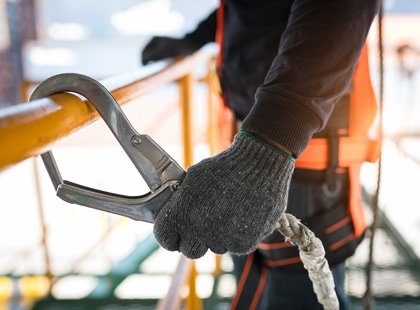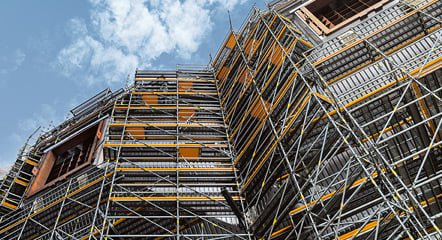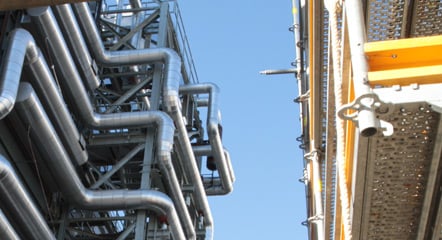A Look at OSHA Scaffolding Requirements
 Review 12 OSHA Scaffolding Rules
Review 12 OSHA Scaffolding Rules
Scaffolding regulations are serious business – according to the US Department of Labor, there are an estimated 2.3 million construction workers working on scaffolds throughout the country. Of those workers, 4,500 are injured and 60 die every year in scaffolding-related deaths. Following proper safety standards could prevent many of these accidents and save American employers an estimated $90 million in workdays not lost.
In addition to being good for your employees and good for business, following scaffolding regulations is a must to avoid getting a citation the next time an inspector comes visiting.
Fortunately, modern scaffolding technology and the availability of online resources detailing OSHA scaffolding requirements makes it relatively straightforward to meet your safety obligations and protect your company.
OSHA Scaffolding Rules
The easiest way to get a big-picture view of OSHA scaffolding requirements is to review our basic outline below. OSHA also offers an eTool where you can review all the Frequently Asked Questions concerning scaffolding and OSHA regulations.
General Overview of OSHA Scaffolding Requirements
1. Stability
All scaffolding needs to be fully stable, which is why you cannot use unsteady supports and objects to maintain stability. Things like boxes, loose building materials and barrels are not appropriate for maintaining stability. Scaffolds that do not have solid footings are breaking OSHA regulations.
2. Weight Capacity
Every scaffold should be capable of supporting at least four times the max intended load – in addition to supporting its own weight. Not only does the scaffold need to support the specified amount of weight but it also needs to do so without shifting or settling. Any sort of displacement under safe loads is prohibited.
3. Material Quality
The planking on scaffolds must meet minimum plank-grade material specifications. The planks need to be tightly spaced to avoid any chance of shifting or slippage through the cracks.
4. Safe Access
Scaffolding must be accessible using safe, stable methods such as ladders or stairs. You cannot access scaffolds using unsafe methods – such as a cobbled-together staircase made of loose bricks or planks.
5. Supervised Setup
Someone who is competent in the process must oversee the building of scaffolding at the job site. According to OSHA, a competent person is someone capable of identifying predictable and existing hazards in your working conditions or surroundings and is authorized to take swift corrective measures to remove them.
Any movement or dismantling of the scaffolding requires similar supervision so that all work is done according to regulations.
6. Maintenance
Scaffolding can go through hard use, and components will wear with use, time and exposure to the elements. You need to maintain every component properly, including braces, trusses, screw legs, brackets, planking and ladders.
7. Added Protection
Guardrails, midrails and toerails are all required on scaffolding. Guardrails need to be between 38 and 45 inches high to meet regulations.
8. Distance from Power Lines
A 10-foot distance is required between all scaffolding and power lines.
9. Instruction on the Risks of Diagonal Braces Used for Protection
It can be tempting to try and use diagonal braces as a protective barrier for scaffolding, but there are serious risks involved in doing so. All your employees need instruction in the hazards of this misguided attempt at safety.
10. Protection of Rigging
The rope used for setting up suspension scaffolding is prone to damage from wear and tear, abrasions and heat. Monitor all of these ropes for degradation and damage and replace them as necessary. Monitoring should be particularly consistent if the ropes are anywhere near a heat source, such as certain pieces of machinery.
11. Inspection of Rigging
Before every shift, the suspension scaffolds you have set up need to be inspected by a competent individual to ensure that all the suspension materials are free of defects or damage. Any damage anywhere in the rigging could lead to failure of the system, leading to injury or death. That is why OSHA requires inspection of these relatively fragile materials every day.
12. Inspection of Scaffolding
You and your team need to determine an inspection schedule that the competent person will adhere to for inspections of the scaffolding. As with the rigging, any small alteration in the scaffolding could lead to structural issues, failures and the associated dangers they present to the workers. Once you set a schedule, make sure that the person responsible for the inspections adheres to it without fail.
Fall Protection and Scaffolding
OSHA requires you to provide fall protection for all of your employees who are working on scaffolding more than 10 feet above a lower level. The scaffolding harnesses and personal fall arrest systems you use to protect your employees should be dictated by the competent person based on the specific circumstances of the job and the scaffolding.
Height Restrictions on Scaffolding
According to OSHA scaffolding rules, a professional registered engineer must design any scaffold that is more than 125 feet high. At such heights, the stress on the scaffolding and the potential hazards to workers are significant enough that the scaffold should be designed to exacting parameters.
Innovative Scaffolding Systems for Modern Construction
Meeting OSHA scaffolding requirements becomes easier when you take advantage of the latest in scaffolding technologies.
AXIOS utilizes advanced scaffolding materials, systems and techniques to deliver the most value for your money and the safest designs available. You can get an exact materials list for a 3D scaffolding design, so you don’t have to worry about assumptions or guesswork. Just let us know what you are planning on building, and we can help you develop a scaffolding system that will meet and exceed your expectations.
Our PERI UP Rosett Flex modular scaffolding system is particularly useful for complex projects that require flexibility along with safety. Contact us to learn more about OSHA scaffolding rules, our expert team and our proven technology.



